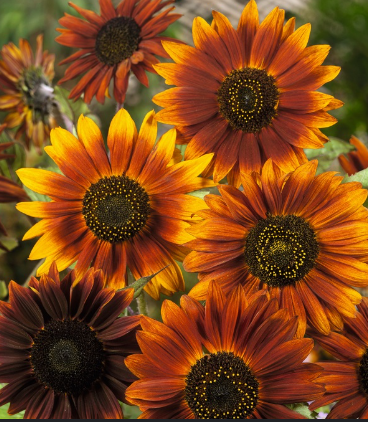Tyler Seeds
Mardi Gras Sunflower
Mardi Gras Sunflower
Couldn't load pickup availability
The Mardi Gras sunflower is a bright and cheerful multi-flowering plant with golden yellow rays around a chocolate center. Honeybees and other pollinators will love them and you'll have plenty for your bouquets. Then after blooming, the songbirds will feed on these oil rich seeds.
Interesting fact: Sunflowers are heliotropic, which means that they turn their flowers to follow the movement of the Sun across the sky from east to west and then return at night to face the east, ready again for the morning sun. Heliotropism happens during the earlier stages before the flower grows heavy with seeds.
Noteworthy Information: Sunflowers thrive in slightly acidic to somewhat alkaline soil (pH 6.0 to 7.5). Sunflowers are heavy feeders, so the soil needs to be nutrient-rich with organic matter or composted (aged) manure. Or, work in a slow-release granular fertilizer 8 inches deep into your soil. A light application of fertilizer mixed in at planting time will encourage strong root growth to protect them from blowing over in the wind. It’s best to sow sunflower seeds directly into the garden (or outdoor containers) after the danger of spring frost has passed, anytime after soils have warmed to at least 50°F (10°C). Once the plant is established, water deeply, though infrequently, to encourage deep rooting. Unless the weather is exceptionally wet or dry, water once a week with several gallons of water. Tall species and cultivars require support. Bamboo stakes are a good choice for any plant that has a strong, single stem and needs support for a short period of time. If fungal diseases are spotted early, spray with a general garden fungicide.
Harvesting Sunflower Seeds: Let the flower dry on or off the stem until the back of the head turns brown, the foliage turns yellow, the petals die down, and the seeds look plump and somewhat loose. If you are going to harvest the seeds for roasting, you can cover the flowers with a light fabric (such as cheesecloth) and a rubber band to protect the heads from the birds. Alternatively, you can cut the flower head early and hang the heads upside down until the seeds are dry. To remove the seeds, rub your hand over the seeded area and pull them off the plant or you can use a fork. Rinse sunflower seeds before laying out to dry for several hours or overnight. If you’re saving seeds to replant, store them in an airtight container in a cool, dry place until you are ready to plant.
Some Wisdom:
- In some cultures, sunflowers are a symbol of courage.
- Need a bird feeder? Save whole, dry sunflower heads and set them out in winter. Birds will gladly pick at the delicious seeds!
- The tallest sunflower ever recorded was grown in Germany in 2014. It measured in at a stunning 30 feet and 1 inch tall!
Roasting Sunflower Seeds: Re-soak seeds overnight in salted water. Run through a strainer and dry on a layer of paper towels. Bake for 25 to 30 minutes at 325 degrees on a baking sheet. Seeds should be spread out in a single layer. Stir frequently during the baking and remove seeds when they look slightly browned. Don’t burn! You can add some olive oil, salt, and spices to your roasted seeds if you wish.

